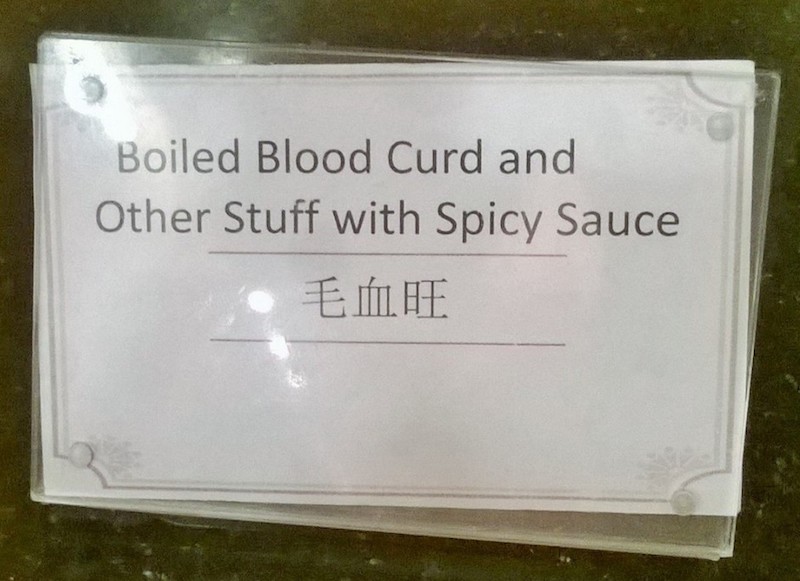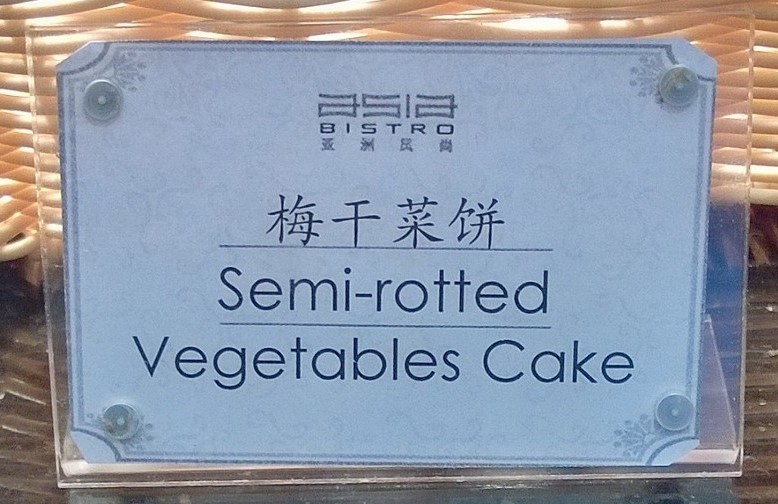"Boiled Blood Curd" and "Semi-rotted Vegetables Cake"
« previous post | next post »
Menu items at the Asia Bistro, Marriott Hotel, Suzhou, China, courtesy of Thomas Malphus:
The Chinese wording on the label says: máoxuè wàng 毛血旺.
Character by character, that means: "hair-blood-prosperous / flourishing / vigorous" — which doesn't sound like anything you'd want to eat.
The English wording on the label is too imaginative and expansive to be credited to a machine translator, for which here are some samples:
Google Translate — "hairy blood"
Baidu Fanyi — "Duck Blood in Chili Sauce"
ichacha — seafood-flavored duck blood and gizzard
Microsoft Translator — Mao Xue Wang (they must have thought it was the name of someone surnamed Mao)
Those don't sound very appetizing either.
As to what this dish really is and how the name should be translated, it gets pretty tricky.
The easiest part is xuè 血, which really and simply does mean "blood". Incidentally, when I learned this word half a century ago, I was taught to pronounce it as xiě or xuě. This is but one of hundreds of common words in Mandarin whose pronunciations (especially the tones) have changed since I began learning the language. For this recipe, the blood is boiled with salt to form a thickly coagulated mass with the consistency of pudding or curd, which is why some people refer to it as xuè dòufu 血豆腐 ("blood bean curd")!
Next hardest to understand is máo 毛, which only superficially seems to mean "hair", but has nothing to do with it. This morpheme is Sichuanese / Chongqingese for "rough; raw". and is pronounced like mào 冒, which is how Sichuanese / Chongqingese would write it if they wanted to convey the way it is pronounced. The character mào 冒 means "risk", but that is also completely unrelated to the morpheme in question. Another example of this Sichuanese / Chongqingese morpheme in action is máotiě 毛铁, which looks like it means "hair iron", but actually means "raw iron", again with máo 毛 being pronounced as mào 冒.
Now for the hardest part of the term, wàng 旺, which superficially means "prosperous / flourishing / vigorous", but again is a Chongqing / Sichuan topolect term, pronounced huǎng 晃. This morpheme has no clear meaning when it occurs alone, but only when it is attached to other morphemes. An example is féicháng wàng 肥肠旺 ("fatty [pork] intestine blood curd"), which is similar to máoxuè wàng 毛血旺 ("blood curd"), which always has "other stuff" and chili sauce mixed in with it, but in this case the proportion of "fatty [pork] intestine" is much greater.
As for a philological note on why wàng / huǎng 旺 might have been chosen to write a blood-related morpheme, this usage may derive from huāng 衁, which is an ancient word for (sacrificial) blood. See at the beginning of the verse section on pp. 324-325 in the 15th year of Lord Xi (645 BC) in the Zuǒ zhuàn 左傳 (Zuo Tradition): Shì kuī yáng, yì wú huāng yě 士刲羊,亦無衁也 ("The fine man stabs the sheep, But it does not bleed").
The exegesis of the name of this Sichuanese / Chongqingese dish is an object lesson in why learning Chinese languages is so difficult, even if you're only dealing with Mandarin. As I never tire of telling my students, it's often better not to dwell overmuch on the characters used to write Sinitic words, because they frequently lead you astray and confuse you. Better to concentrate on the sounds and meanings of the words than the forms of the characters.
Let us move on to another intriguing name for a dish at the same restaurant:
While far less linguistically challenging, this one is perhaps equally entertaining.
As given on the label, the Chinese name says: méigān cài bǐng 梅干菜饼.
Character by character, that means: "plum-dried-vegetables-([
The problem here is that there are so many alternative ways to write the name of this type of cake:
méigān cài bǐng 梅干菜饼 / 霉乾菜餅 / 梅乾菜餅 /梅干菜餅 / 黴干菜餅
黴 and 霉 basically mean the same thing, "mold; mildew; (bacteria; fungi)", hence, I suppose, giving rise to the "semi-rotted" in the English on the label. 干 and 乾 are different ways for writing gān ("dried").
Though it ostensibly means "plum", the méi 梅 of méigān cài 梅干菜 is said to stem from Méizhōu 梅州 in Guǎngdōng 广东 Province.
Here are some remarks from informants about the different nuances between méigāncài 梅干菜 and méigāncài 霉乾菜:
Some people say 梅干菜 and 霉干菜 are the same thing, just different names. But some argue that 霉干菜 is a special local product of Shaoxing 绍兴 in Zhejiang Province while 梅干菜 is from Meizhou in Guangdong Province 广东梅州. These two products taste slightly different. However, both types are made the same way (with salt and sun).
梅干菜 is popular in northeast China. It refers to salted sun-dried vegetables, such as leaf mustard and potherb mustard. 霉干菜 is similar to 梅干菜, but is darker in color. So it is also called wū gāncài 乌干菜("dark dried vegetable"). It seems 霉干菜 is steamed before processing. I searched online and it says 霉干菜 is from Shaoxing 绍兴 in Zhejiang Province, while 梅干菜 is from Meizhou 梅州 in Canton Province. Anyway, there is not much difference in terms of taste.
As for 梅菜, it is a kind of salted vegetable, made from fresh potherb mustard, in Chinese, xuělǐ hóng 雪里蕻, which is sometimes called 梅菜. So it is quite tricky that 梅菜 can refer to both salted 雪里蕻 (霉干菜) and fresh 雪里蕻. One thing to notice that is we seldom call 雪里蕻 as 梅菜. So it is unidirectional. Dried and salted 雪里蕻 is 霉干菜,also 梅菜,or dried 梅菜(梅干菜). I guess it is strange to describe food as 霉 ("rotted"), though we have fǔrǔ 腐乳 ("fermented bean curd") or méi dòufu 霉豆腐 ("molded / mildewed tofu"), and chòu guìyú 臭鳜鱼 ("stinky Mandarin Fish"), we usually write the dish in the form of 梅干菜 or 梅菜, such as méicài kòu ròu 梅菜扣肉 or 梅干菜扣肉 (they are the same thing, "braised pork with preserved vegetable"). Besides, in my mental lexicon, 霉菜 always means 霉干菜 and the salted or dried 梅菜, 梅干菜.
No matter where it comes from or what it's called (i.e., how it's written), here are some notes from Wikipedia on how this extremely flavorful preserved vegetable is made:
Meigan cai (simplified Chinese: 梅干菜; traditional Chinese: 霉乾菜; pinyin: méigān cài; Wade–Giles: mei2-kan1 ts'ai4; literally: "molded dried vegetable"; or mei cai (simplified Chinese: 梅菜; traditional Chinese: 霉菜; pinyin: méi cài; Wade–Giles: mei2 ts'ai4) is a type of dry pickled Chinese mustard of the Hakka people from Huizhou, Guangdong province, China. Meigan cai is also used in the cuisine of Shaoxing (绍兴), Zhejiang province, China and in Taiwan.
The pickle consists of a whole head of various varieties of Chinese mustards and cabbages (芥菜 (leaf mustard)、油菜 (rape)、白菜 (Chinese cabbage) that has undergone an elaborate process consisting of drying, steaming, and salting. The vegetables are harvested, trimmed before the Qingming Festival, and sun-dried until limp. It is then salted or brined, kneaded until the juices are exuded, and left to ferment in large clay urns for 15 to 20 days. The vegetable is then repeatedly steamed and dried until reddish brown in colour and highly fragrant.
This pickled vegetable is used to flavor stewed dishes, in particular Meigan cai cooked with pork (梅菜扣肉/梅干菜烧肉)) or for Meigan cai baozi (梅菜菜包). Meigan cai was formerly a tribute item to the imperial palace in the Qing Dynasty.
Finally, let me say that meigan cai made from xueli hong is one of my very favorite things in Chinese cooking.
[h.t. Paula Roberts; thanks to Yixue Yang, Jing Wen, Jinyi Cai, and Qing Liao]


Laura Morland said,
September 17, 2018 @ 11:40 pm
Thank you for the erudite explication, which is making me yearn for meigan cai!
(In my experience, Other Stuff tastes pretty bland without the Spicy Sauce.)
AntC said,
September 18, 2018 @ 5:51 am
Seconded! I've been eating meigan cai -seasoned dishes in Hakka restaurants in Taiwan recently.
Victor Mair said,
September 18, 2018 @ 5:19 pm
From Zeyao Wu:
梅干菜 and 霉干菜 are not the same thing. 梅干菜 is a kind of pickle in Guangdong area, and my mother-in-law is good at making it. It is made of Chinese mustard green 芥菜. But for 霉干菜, it is a Zhejiang dish, and it is made by drying in the sun.